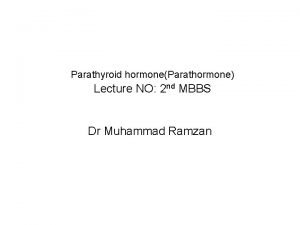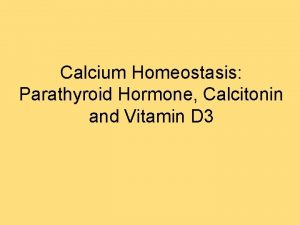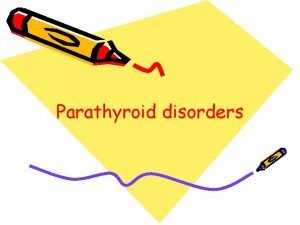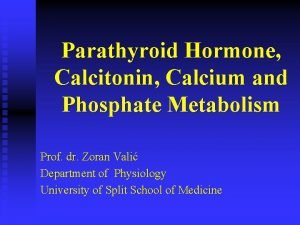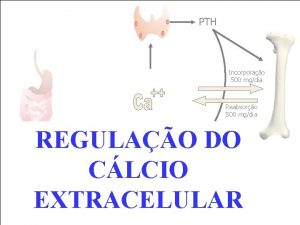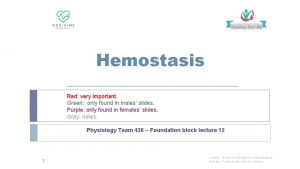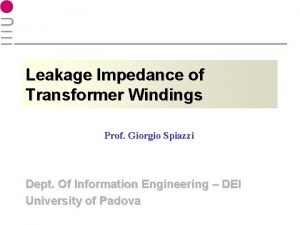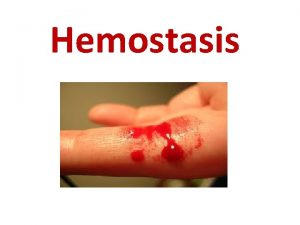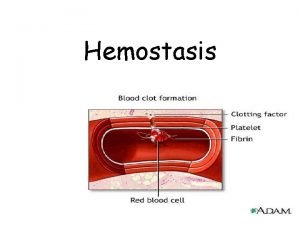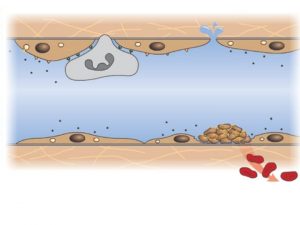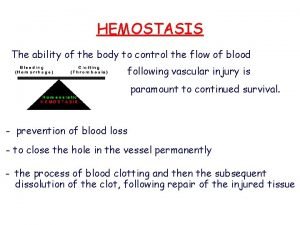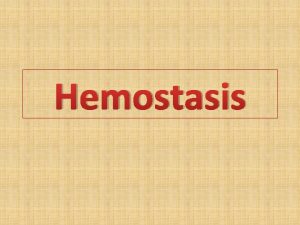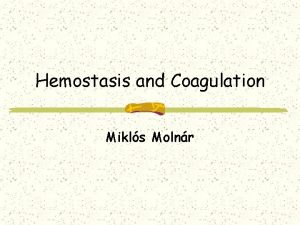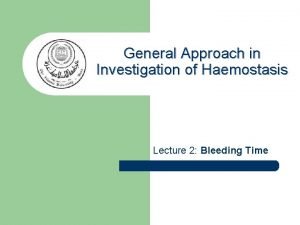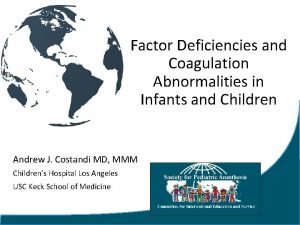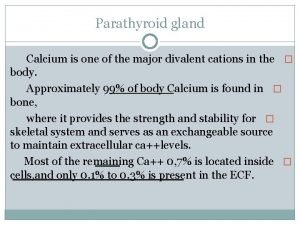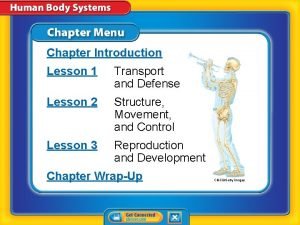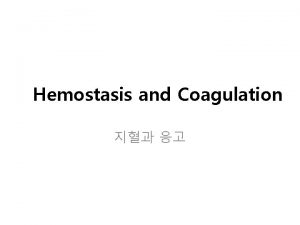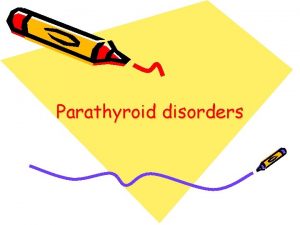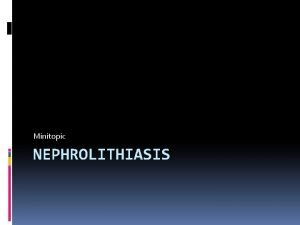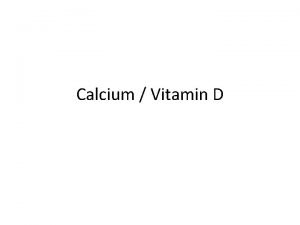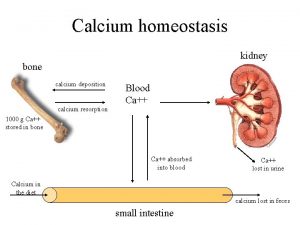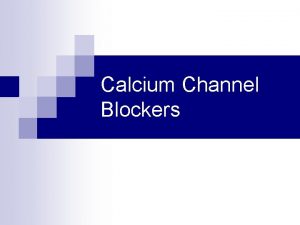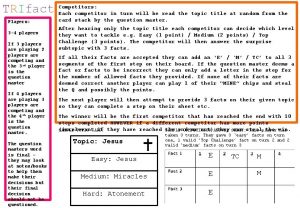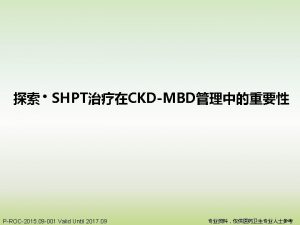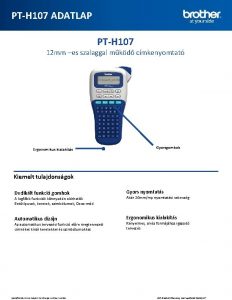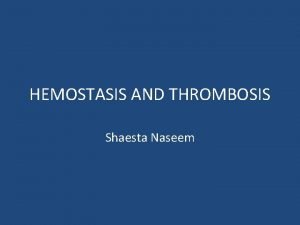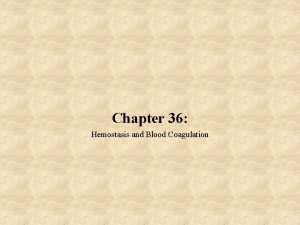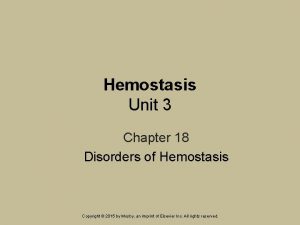PTH hormone and calcium hemostasis Outline Key players








































- Slides: 40

PTH hormone and calcium hemostasis

Outline ü Key players of Calcium hemostasis üParathyroid hormones ( Function, Regulation, Pathophysiology) üVit D üCalcium üCalcitonin

PTH • Anatomy (briefly) • Importance of Ca and its percentage in blood • Impairment level of Ca and its consequences • Regulation of Calcium level • PTH and its Functions • Relation between Calcium and bone phosphate • Gut

Parathyroid Glands üChief cells secret PTH ü oxyphil cells

“Calcium level is normally always around 11 mg/100 ml of plasma”

Calcium : functions • maintenance of normal sodium permeability in nerves • Involved in triggering the release of acetylcholine from nerve endings at the neuromuscular junction • Necessary in excitation-contraction coupling in muscle cells • Serves as an intracellular signal for some hormones(2 nd Msn) • Required by some enzymes for normal activity • Required for blood clotting to occur normally • Required for protein secretion • Constituent of bone About 99% of our body's calcium is deposited in the bones and teeth.

Calcium : functions Key players ( Na, Ach , muscle contraction, other hormones and enzymes , blood clotting, protein secretion , bone)

Calcium : diffusible Vs Non diffusible


Impaired level of Calcium (Hyper Vs Hypo)

Regulation of Calcium levels

Calcium Hemostasis : PTH , Calcitonin & Vit. D Ca 3(po 4)2

PTH hormone • single chain protein • PTH is free in plasma • short half-life • PTH has two types of receptors (sometimes three) • second messenger either cyclic AMP or (DAG and IP 3)

Functions and effects • On Kidney (increase Ca re-absorption, Phosphate Excretion, and the synthesis of Vit. D (1, 25 -(OH)2 -D) ) • On the intestines: increase Ca++ absorption • On bones: increase resorption of Ca and Phosphate [then phosphate will be excreted through the kidneys] • other


Regulation (loops) PTH secretion , regulated by: • Ca++ (mainly) • Others ( Mg , Vit D , NT)

pathophysiology “Hypo Vs Hyper” tetany vs stones. groans. bones. phycatri c overtones

Calcium and bone phosphate


Gut

The second major regulator of the Ca level: Vit D • Hormone or vitamin • D 3 (skin) , D 2 (diet)

Vit D : Synthesis



Vitamin D and Obesity

When α-1 -hydroxylase is activated • Vitamin D deficiency • Ca 2+ deficiency • phosphate deficiency • PTH stimulation Why To Increase Ca and PO

When 24 -hydroxylase is activated • excess Ca 2+ • excess phosphate • excess 1, 25 -(OH)2 -D

Acidemia Vs Alkalemia


Clinical applications : Rickets & Osteomalacia & many other things : P

Calcitonin counter PTH • straight chain peptide of 32 amino acids • Parafollicular cells • neuromodulator. •

The major stimulus to CT secretion is a rise in plasma calcium concentration

Calcitonin • decreases plasma calcium levels (by antagonizing the actions of PTH on bone and on the kidney decrease Ca and phosphate reabsorption). • decreases plasma phosphate concentration and increases urinary phosphate excretion slightly

The hypocalcemic action is caused by inhibition of both osteocytic osteolysis and osteoclastic bone resorption particularly when these are stimulated by PTH

CT deficiency does not lead to hypercalcaemia & CT hyper secretion does not produce hypocalcaemia.


factors affecting calcium metabolism (other than PTH, CT, and vitamin D) • • • include: Glucocorticoids Growth hormone and somatomedins Thyroid hormones Estrogens Insulin IGF-1 Epidermal growth factor Fibroblast growth factor Platelet-derived growth factor Osteoclasts activating factor

Phosphate


Osteoporosis
 Parathyroid hormone
Parathyroid hormone Function of calcitonin
Function of calcitonin Trosseau sign
Trosseau sign Calcitonin and pth are antagonistic hormones
Calcitonin and pth are antagonistic hormones Bone fluid
Bone fluid Reabsorção óssea
Reabsorção óssea Serorotin
Serorotin Pth stable coin
Pth stable coin Sơ đồ truyền máu
Sơ đồ truyền máu Dowell curves
Dowell curves 13 blood clotting factors list pdf
13 blood clotting factors list pdf Hemostasis
Hemostasis 1ry hemostasis prescribed by
1ry hemostasis prescribed by Saddle blood clot
Saddle blood clot Skema hemostasis
Skema hemostasis Hypocalcemia causes
Hypocalcemia causes Primary hemostasis
Primary hemostasis Calcitonine
Calcitonine Subendotel
Subendotel Hemostasis
Hemostasis Primary hemostasis
Primary hemostasis Mielke method bleeding time
Mielke method bleeding time Haemophilia a b c
Haemophilia a b c The major key players on the international side are the
The major key players on the international side are the Key players in tourism industry
Key players in tourism industry Which company is recognized as the inventor of cruising
Which company is recognized as the inventor of cruising Maimunah aminuddin
Maimunah aminuddin The major key players on the international side are the:
The major key players on the international side are the: The major key players on the international side are the
The major key players on the international side are the Key players definition
Key players definition The major key players on the international side are the
The major key players on the international side are the Countries near cuba
Countries near cuba Example of sentence outline about education
Example of sentence outline about education Key activities
Key activities Contoh bisnis model canvas makanan pdf
Contoh bisnis model canvas makanan pdf Parathyroid hormone and calcitonin
Parathyroid hormone and calcitonin Two football players collide and stick together
Two football players collide and stick together Baddeley and hitch rugby players
Baddeley and hitch rugby players Scrap heap magnet circuit diagram
Scrap heap magnet circuit diagram Transport and defense lesson 1 answer key
Transport and defense lesson 1 answer key The science duo physical and chemical changes
The science duo physical and chemical changes
